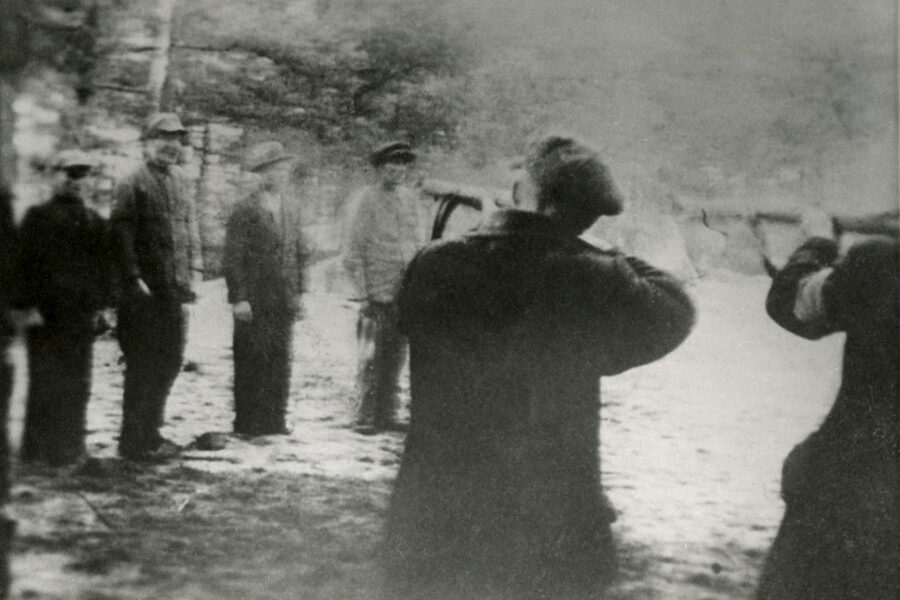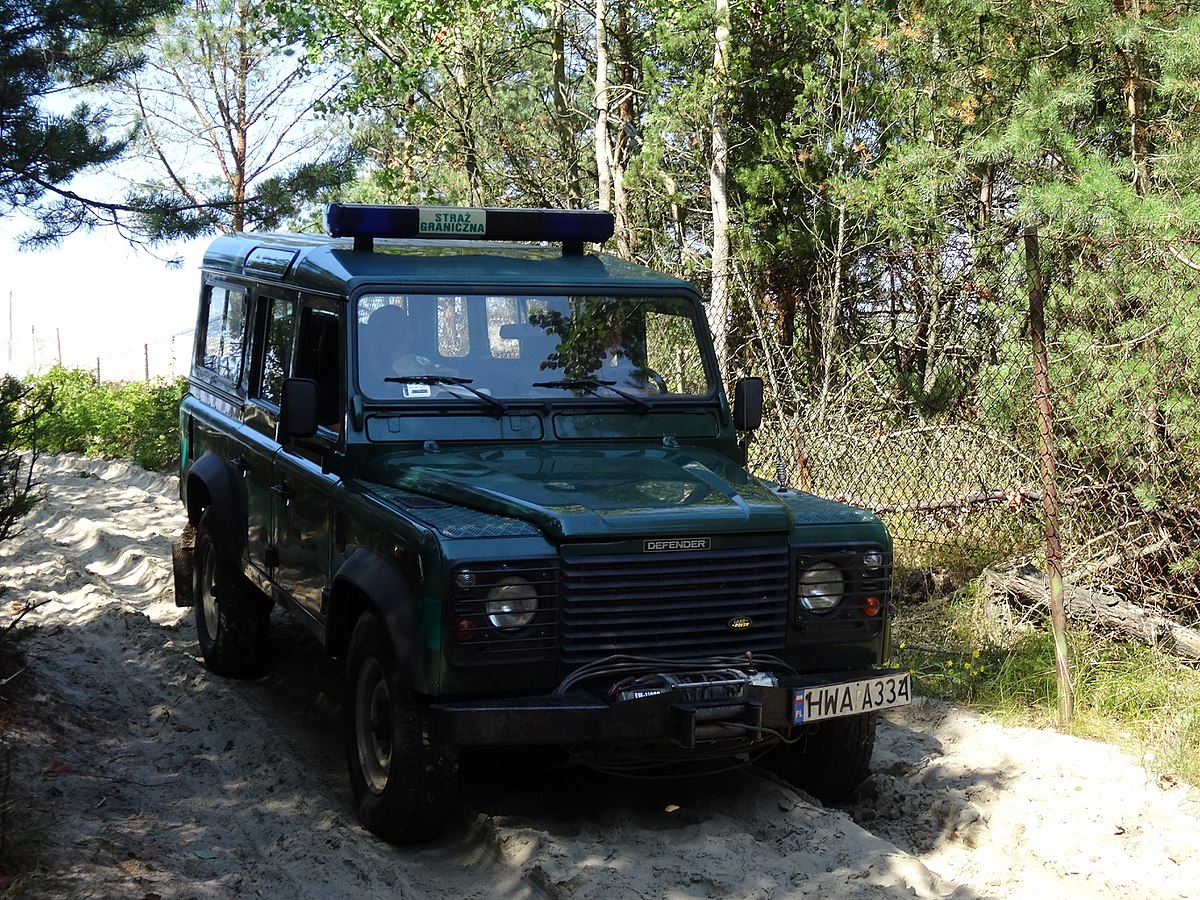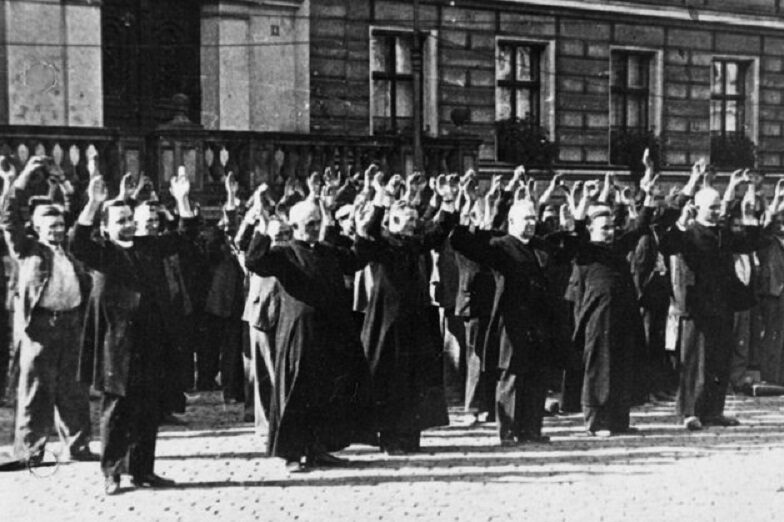Extermination of Polish Elites. These were the first mass murders of WW2 in Europe

The Poles from areas annexed to the Reich fell victim to a barbaric extermination operation Intelligenzaktio
Maciej Rosalak
Especially vicious Gauleiter in Gdansk, Albert Forster, bellowed in September 1939: “We must eradicate those rotten Poles, starting from the cradle. I put their fate in your hands, you can do whatever you want with them!”. German crowd roared back: “Let those Polish dogs die!”, “Death to the Poles!”.
It did not end with the shouting. The German minority in the Polish Pomerania, which previously acted as the fifth column, dangerous to the country and the Polish Army, now, to a great extent, turned into bloodthirsty denunciators and executioners of the best and most prominent Poles in local communities. From the beginning of the war, they took part in murdering Polish elites, precisely – as it is with Germans – planned by the Third Reich authorities.
Organized murder
The Intelligentsia Action (German: Intelligenzaktion) started with the annexation in the second half of October 1939 of Pomerania with Powiśle, Wielkopolska, Silesia, Northern Masovia and Łódź to the Third Reich. Ten million people lived there before the war, of which 9 million were Poles. The Germans did not represent even 10 percent. The annexation of Polish lands involved the takeover by administrative authorities of supervision over their “safety”. Before that, they were theoretically governed by Wehrmacht, but Poles were killed here mainly by six murderous Einsatzgruppen under the name Tannenberg. I say “mainly” because Wehrmacht also shot and hanged defenceless civilians, e.g., in Kłeck near Gniezno – or helped the Police, SS and Gestapo. Also Selbstschutz militant groups comprising local Germans and Volksdeutsche participated in murders.
Those actions, just as Intelligenzaktion (it is considered to have started already in September), which was a continuation of the Tannenberg operation and all other bestialities from the beginning of the war, stemmed from plans for German invasion of Poland prepared already from 1934., and started by … signing a non‑violence declaration with the pre-war Poland. The annexation of our territories involved the plan to eliminate the Polish elite. The effect was, among other things, the compilation and printing in the summer of 1939 by SD (SS security service) of the “Special Book of Poles against whom arrest warrants have been issued” (German: Sonderfahndungsbuch Polen).
It was an alphabetic list with over 61 thousand names of Poles of special merit for their homeland, and thus dangerous – according to SS – to the Third Reich. They could have been leaders for the Polish communities. The list included civil servants, local leaders, landowners and businessmen, academics and teachers, officers, lawyers, social activists, priests, monks and nuns, scouts, veterans of the fight for Poland’s freedom… Those who were “omitted” when the list was compiled, were promptly added after the German invasion, with the use of eager local Germans, often settling personal feuds and taking over the property of captured Poles.
The “hunted” lists were lists of death. As late as by April 1940, as part of Intelligenzaktion those captured were murdered (50 thousand) or deported to concentration camps (another 50 thousand), mainly to the Stutthof concentration camp, built for this particular purpose, to Hohenbruch and Mauthausen-Gusen. In a large majority of cases this also meant death. That way almost 100 thousand representatives of the elite of our nation were exterminated in Wielkopolska, Pomerania, Silesia, but also in Łódź and Norther Masovia.
Besides murdering the elite, several hundred thousands of Poles from those areas were deported to Germany for forced labour, and over one hundred thousand were expelled to the General Governorate. Their property was robbed. By the end of 1940 the number of Polish exiles was over a quarter million people.
Murders, incarceration, exile and deportation to slave labour continued also after the end of Intelligenzaktion. Germans, as mentioned, had big plans before the war and the conquests inspired them to formulate the General Plan for the East (German: Generalplan Ost) in 1941. It was to ensure them Lebensraum at the expense of nations living to the east of Germany. According to that plan, all Jews, 80–85 percent of Poles, 50 percent of Czechs and Moravians, 65 percent of Ukrainians, 75 percent of Byelorussians and an indeterminate percentage of Russian and Tatars were to disappear from there (that is, lose their lives). Slavs who stayed in their old territories were to be turned into uneducated slaves obedient towards their “German masters”.
There was no room for Polish intellectuals in Nazi’s racist assumptions and as of 1941 in their specific plans, therefore, they had to disappear first.
Pomeranian Palmiry
The largest group, in absolute and relative terms, murdered during Intelligenzaktion, were Polish Pomeranians: 23 thousand, and including Jews and Poles brought here from Germany, the number of victims of executions was as high as 40 thousand. Definitely, such large number of murdered people is connected with particularly vicious and anti-Polish attitude of Albert Forster, who was nominated as Gauleiter of the newly created Reich province Gdansk-West Prussia. Arthur Greiser in Wielkopolska and Fritz Bracht in Upper Silesia – though also criminals – endeavoured to a greater extent to germanise inhabitants instead of exterminating them. Poles from Gdansk, Gdynia, Wejherowo, Starogard and Puck were executed mainly in Piaśnica Woods near Wejherowo, at Mniszek near Świecie, at Las Szpęgawski near Starogard. From 1.2 thousand to 1.4 thousand Poles were executed in Fordon Death Value, on the outskirts of Bydgoszcz. At Chojnice Death Valley, two thousand Poles were executed, and on Morzewskie Hills near Chodzież – a few thousand.
Occupants tried to keep executions in Piaśnica Woods, known as Pomeranian Palmiry and Katyń, secret, however, thanks to the testimony of few local Poles and post-war German testimonies – the harrowing circumstances came to light. Victims – men, women, children, were treated with utmost brutality. They were transported from prisons, forced to undress and kneel over death pits, and then shot from machine guns or shots to the back of a head. It continued both during a day and at night, in car lamplights. After the war evidence of torture was discovered on bodies. People who were still alive were delivered a lethal blow with a butt. Probably there were instances of burying people alive. Little children were killed by smashing their heads against trees (macabre traces of such practices were discovered on trunks). Surely, ammunition was to be saved. Murderers from SS would sum up their courage by drinking alcohol – after the war, empty bottles were found among the bodies in the pits. Victims’ clothes were carefully collected and transported to Wejherowo with the same trucks that previously brought those unfortunates to the place of slaying. The clothes were given – how considerate! – to Nazi social welfare services. 12 thousand Poles lost their lives in Piaśnica Woods.
Among those murdered in Piaśnica, who could be identified, a particularly big group were consecrated persons. In 1999, John Paul II beatified 108 Polish martyrs from the last world war. Among them was Sister Alicja Jadwiga Kotowska. She was a nurse during the previous world war and during the war with Bolsheviks, and participated in Polish Military Organization. In 1922, she joined the Congregation of the Sisters of Resurrection. Later, she graduated from medical studies at the Warsaw University, became a teacher, and in the 1930s was the principal of a school in Wejherowo. She was forty when Germans murdered her for her devotion to God and her homeland.
In 2003, the beatification process started of another victim from Piaśnica – priest Anastazy Kręcki. After graduating from philosophical and theological studies he was ordained in 1920 and served as a vicar first in Starogard Gdański and Tyłów, and later as a parish priest in Strzelno, organizing the life of the local community. He established a Volunteer Fire Department and a dairy cooperative, organized Kashubian embroidery course, sewing and cooking courses and helped local victims of home fires. He brought organs and bells for the parish church, built a parish house to be used by the local community. He also took care of the local theatrical club. Arrested by Germans in the autumn of 1939 and murdered.
Witold Krukowski was put by Germans on the black list of enemies of Reich for his outstanding business and public skills and achievements. The son of a merchant and factory owner, after studying law and economy in Germany, already before the first world war he bought out many enterprises from German hands and established Bank Dyskontowy SA in Bydgoszcz. He established Polish journals “Gryf” and “Pomorzanin”. In 1918, he became a delegate to the Polish Provincial Sejm (Parliament) in Poznan. In 1919, he bought land in Kolibki from Walter von Schütze, as a result of which the estate located in the disputed area of a boundary between the Free City of Gdansk and Poland was incorporated into the Polish territory. He created a housing district and a beach resort in Orłowo there. He offered land for other Polish public projects. He was also an honorary consul of Estonia in Gdansk. Arrested immediately after Germans entered the area, he was murdered and his family was deported to concentration camps.
Another outstanding person was Najman-Mirza Kryczyński, a Tatar historian and lawyer, who after the February revolution in Russia organized Muslim troops and became the President of Petersburg Muslim Club. In liberated Poland he worked as a lawyer in Vilnius, Zamość and Gdynia, was a member of the Polish Oriental Society and a founder of the National Tatar Museum in Vilnius. He was captured by Germans in October 1939 and murdered probably in the spring of 1940.
Leon Wzorek – a worker from Podkarpacie – during the first world war he belonged to POW, and later served in the newly established Polish Navy. He was a crew member of ORP Pomorzanin, our first war ship. After military service he took up a different service – as a lighthouse keeper at Rozewie. He placed a plaque to commemorate that Stefan Żeromski stayed there and wrote “Wind from the Sea”. He was the president of a unit of the Polish Western Association. Germans arrested him when on duty at the lighthouse and murdered him in Piaśnica, probably on 31 December 1939.
In Fort VII and other places
And here are losses we have suffered in other most indigenous parts of Poland, attached to the Third Reich, during Intelligenzaktion.
Extermination of Polish intellectuals and leaders in Wielkopolska – incorporated into Reich as Warta Land (German: Warthegau) – started immediately after the Germans invaded Poland in September 1939. Public executions of local elites (almost 300 victims) were organized, among others, in Śrem, Książ, Kórnik, Środa, Kostrzyń, Gostyń, Poniec, Krobia, Kościan, Śmigiel, Leszno, Osieczno, Włoszczakowice… The place that achieved the grimmest fame was Fort VII of Poznan Citadel, where during Intelligenzaktion two thousand Poles were murdered, among them the most outstanding citizens (and by the end of the German occupation – 20 thousand). Among the persons who met their death here were:
Stefan Cybichowski – an engineer, architect and a member of Poznan City Council (murdered in January 1940);
Mścisław Frankowski – an insurgent in Wielkopolskie Uprising, an activist of National Combat Organization. From December 1940 imprisoned in Fort VII, and guillotined in the Plötzensee prison on 20 March 1942;
Stanisław Kalandyk – a physicist, a professor of Poznan University (most probably tortured to death in January 1940);
Mikołaj Kiedacz – a lawyer, the President of Poznan (murdered already on 25 October 1939);
Roman Konkiewicz – a doctor, an insurgent in Wielkopolskie Uprising, for many years the Chairman of Provisional Board of the Polish Western Association (murdered in January 1940);
Czesław Michałowicz – a priest, for many years the Secretary of the Catholic Association of Polish Workers in Poznan (died a martyr’s death in November 1939);
Wincenty Nowaczyński – a colonel of the Polish Army (died in January 1940);
Stanisław Pawłowski – a geographer of international recognition and outstanding academic achievements, a professor of Poznan University, a member of the Polish Academy of Sciences (PAU), Vice President of Poznan Branch of Maritime and Colonial League (died in January 1940);
Leon Prauziński – a painter and insurgent, an author of paintings and graphics commemorating Wielkopolskie Uprising (died in January 1940);
Celestyn Rydlewski – a doctor, participated in the Paris Peace Conference with Germans (1919), a member of the international borderline commission for delineating the borders between Poland and the Free City of Gdansk (imprisoned in Fort VII, later murdered outside the Fort in 1940).
In the Upper Silesia during Intelligenzaktion two thousand Poles were murdered. Among them there were many insurgents from Silesia Uprising, activists during the Upper Silesia plebiscite, journalists, politicians, intellectuals, officials and clergy. There was no mercy for those who fought to incorporate Upper Silesia into Poland.
Among them was Kazimierz Kierzkowski, a soldier of Polish Legions in World War I, a major of the Polish Armed Forces, who in 1920 was appointed as the Chief of Staff in the Chief Command of the Polish Military Organization in Upper Silesia and prepared the final, decisive Silesian Uprising. The battles of the September campaign were still raging when he started the White Eagle Organization. He operated under the code name: Kazimierz I and Chairman.
In the years 1940–1941 he was the head of the Information and Propaganda Bureau for the Union of Armed Struggle (ZWZ) Krakow-Upper Silesia. Kierzkowski’s name was on the list “Sonderfahndungsbuch Polen”. He was arrested during Intelligenzaktion Schlesien, sent to Auschwitz-Birkenau, where he was murdered in the Summer of 1941.
In the norther Masovian, which was annexed to East Prussia as Regierungsbezirk Zichenau – Intelligenzaktion claimed some 6.7 thousand victims, mainly, from local elites of Ostrołęka, Wyszków, Ciechanów, Wysokie Mazowieckie, Łomża and their vicinity. Many officials, teachers and clergymen, as well as Jews, were killed to germanise the areas as soon as possible. The region was under the bloody reign of East Prussia Gauleiter Erich Koch, particularly murderous official of the Nazi regime.
Intelligenzaktion Litzmannstadt (under such changed name Łódź was annexed to the Third Reich) started at the end of the first ten days of November 1939. Hundreds of Polish intelligentsia representatives were arrested from Łódź and neighbouring towns such as Pabianice, Konstantynów Łódzki, Brzeziny and Zgierz. They were incarcerated in a temporary camp at Michał Glazer Factory in Radogoszcz, and later five hundred of them were selected and executed in Lućmiersz Woods in the vicinity. Executions continued until Spring 1940. They claimed 1.5 thousand victims. Later young Polish men and even boys, arrested in May 1940, started to be brought to the Radogoszcz prison. They were first deported to KL Dachau, and then to Mauthausen-Gusen, the heaviest of German concentration camps because of works in quarries and special cruelty of the staff – only few survived the camp. Finally, next year 175 clergymen from Łódź Diocese, who had not been previously arrested, were captured and sent to Dachau. Forty of them never came back from this allegedly least heavy incarceration place.
Comrades in Murder
We must of course remember that we were losing our elite not only in areas annexed to the Reich. Apart from murders during military actions and retributory executions such as in Wawer, the Germans organized special actions (German: Sonderaktion) in the General Governorate, identical to Intelligenzaktion. There were two Sonderaktion Krakau, when, among others, Jagiellonian University professors were arrested and sent to concentration camps; Sonderaktion Lublin, whose victims were mostly clergymen and professors of Lublin Catholic University, and Sonderaktion Tschenstochau. In November 1939, after an unsuccessful Hilter assassination attempt by Georg Elser in Munich (which had nothing to do with Poles), Germans organized Sonderaktion Bürgerbräukeller, during which several hundred intellectuals were arrested in the whole General Governorate. Every pretext was good.
Let us also remember that the extermination of the Polish elite by Germans was matched by equally cruel extermination of elite by the Soviets. Those members of our nation were murdered during the Red Army invasion, which started on 17 September; they were arrested based on criteria similar to those applied by Germans, sent to deadly homelessness in Kazakhstan and Siberia, and murdered during the Katyń genocide. The similarity of purpose, method and time is striking. How to crush Polish intelligentsia must have been a subject of debate between the representatives of NKWD and Gestapo during conferences held by them in Brześć, Przemyśl, Krakow and Zakopane.
The war ended more than 70 years ago, and the West still does not realise the exceptional tragedy of Poland and Poles, which started in September 1939. And yet no other country of the conquered Europe experienced such murderous crimes of two occupants at the same time, and each of them separately, in particular, the extermination of the leaders of the conquered nation. People in France, Belgium, the Netherlands, Norway, and Denmark, but even in the Czech Republic, Slovakia, Hungary and Romania, are not aware of the difference between German presence in their territories and the occupation of Poland. And this concerns – which must be strongly emphasized – not only the Soviet terror but also German.
This article was published in 2016 in “Do Rzeczy” weekly magazine



